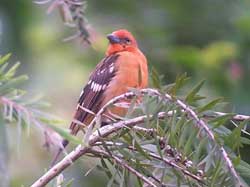According to a study conducted at Stanford University (California) and published in the Proceedings of the National Academy of Sciences, by the year 2100, nearly 10% of bird species worldwide could disappear. Among these, approximately 179 species are currently at high risk of extinction.
 |
| Photo: Samasati |
The authors gathered data related to 9,916 known bird species and presented three scenarios to extrapolate observable trends regarding extinction from 1994 onwards.
The first scenario is based on the assumption that current species assessed as endangered will continue to disappear at the observed rate. In this scenario, 10% of species will gradually vanish.
The second scenario is based on an optimistic assumption that no new species will be classified as threatened; this means only 15 bird species will go extinct from now until 2100 (thus, less than 6% of the species will be extinct).
Finally, the third scenario, the most pessimistic, assumes that the number of threatened species will increase at a rate of 15 species per decade, meaning nearly 1 in 6 species will become extinct by the end of this century (approximately 16% of existing species).
With such prospects, according to these scenarios, 7%-25% of bird species will be threatened with extinction or will live in captivity (taken for breeding).
Among other determining factors of extinction risk, the authors pointed out: habitat destruction and nesting site loss, hunting of rare bird species for sale in pet stores, the introduction of invasive predators (cats, rats, etc.) into certain areas, and climate change which may alter the behaviors of some species.
Subsequently, the American research team analyzed the impact of declining bird biodiversity on the environment, human health, and the economy.
The research team synthesized studies conducted on the various ecological roles of birds (pollination, scavenging by vultures, pest control, etc.). For researchers, the consequences of future extinctions are as dire as the repercussions related to the prioritization of endemic species— which are difficult to replace and vulnerable due to their dependence on specific ecosystems.

















































